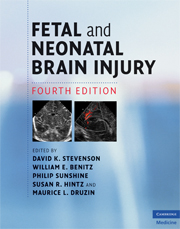Book contents
- Frontmatter
- Contents
- List of contributors
- Foreword
- Preface
- Section 1 Epidemiology, pathophysiology, and pathogenesis of fetal and neonatal brain injury
- 1 Neonatal encephalopathy: epidemiology and overview
- 2 Mechanisms of neurodegeneration and therapeutics in animal models of neonatal hypoxic–ischemic encephalopathy
- 3 Cellular and molecular biology of hypoxic–ischemic encephalopathy
- 4 The pathogenesis of preterm brain injury
- Section 2 Pregnancy, labor, and delivery complications causing brain injury
- Section 3 Diagnosis of the infant with brain injury
- Section 4 Specific conditions associated with fetal and neonatal brain injury
- Section 5 Management of the depressed or neurologically dysfunctional neonate
- Section 6 Assessing outcome of the brain-injured infant
- Index
- Plate section
- References
1 - Neonatal encephalopathy: epidemiology and overview
from Section 1 - Epidemiology, pathophysiology, and pathogenesis of fetal and neonatal brain injury
Published online by Cambridge University Press: 12 January 2010
- Frontmatter
- Contents
- List of contributors
- Foreword
- Preface
- Section 1 Epidemiology, pathophysiology, and pathogenesis of fetal and neonatal brain injury
- 1 Neonatal encephalopathy: epidemiology and overview
- 2 Mechanisms of neurodegeneration and therapeutics in animal models of neonatal hypoxic–ischemic encephalopathy
- 3 Cellular and molecular biology of hypoxic–ischemic encephalopathy
- 4 The pathogenesis of preterm brain injury
- Section 2 Pregnancy, labor, and delivery complications causing brain injury
- Section 3 Diagnosis of the infant with brain injury
- Section 4 Specific conditions associated with fetal and neonatal brain injury
- Section 5 Management of the depressed or neurologically dysfunctional neonate
- Section 6 Assessing outcome of the brain-injured infant
- Index
- Plate section
- References
Summary
Introduction
Since the publication of the first edition of this text in 1989, a great deal has been written regarding the issues of neonatal asphyxia and hypoxic–ischemic encephalopathy (HIE) in term and near-term infants. These manuscripts have addressed the incidence, etiology, pathophysiology, treatment, and outcome of such patients, often relating outcomes to the development of cerebral palsy (CP) and/or mental retardation in survivors. Much of the understanding of the pathophysiology has been the result of studies carried out in laboratory animals, which have been extrapolated to the human fetus and newborn. Additional studies of complications and outcome have been population-based, comparing the injured infant to carefully selected normal controls. These studies have added a great deal to our understanding of risk factors for brain injury, and have enhanced our ability to predict and to identify patients with increasing accuracy. This has become increasingly important, as newer modalities of treatment have evolved which require more precision in the early identification of these infants so that the validity of these therapies can be ascertained. As can be seen in Chapters 39, 41, and 42, early institution of treatment becomes of paramount importance if an improved outcome is to be achieved.
While some still believe that the major injuries in these patients occur in the intrapartum period, many studies suggest otherwise, and allude to the fact that many of the problems arise antenatally, and may be exacerbated in the intrapartum period.
- Type
- Chapter
- Information
- Fetal and Neonatal Brain Injury , pp. 1 - 13Publisher: Cambridge University PressPrint publication year: 2009
References
- 1
- Cited by



